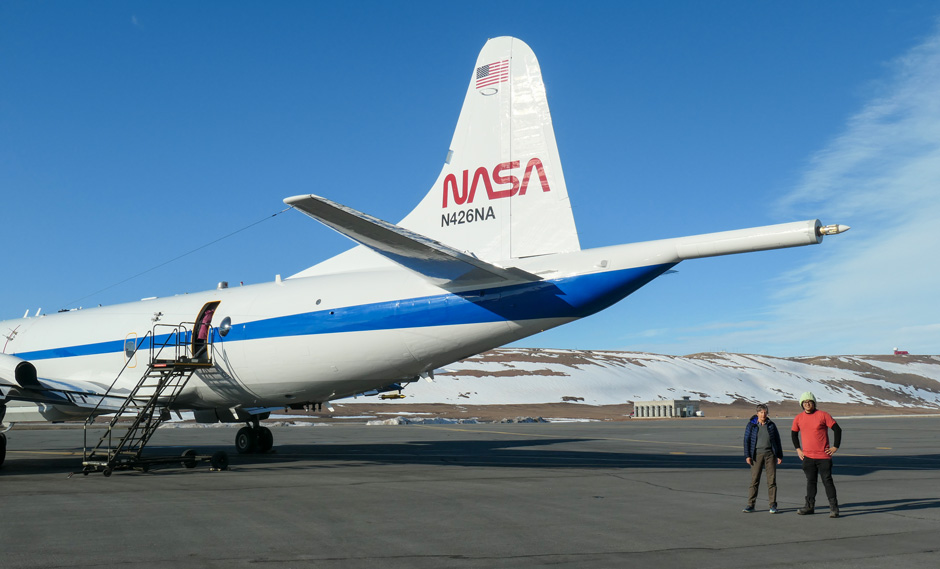By Robert C. Jones Jr., University of Miami News
Earth’s air conditioner is on the blink, and a University of Miami researcher, using a “toolbox” of state-of-the-art scientific instruments, has been delving deeper into the reasons why.
During two recent deployments at the top of the world, atmospheric scientist Paquita Zuidema flew on a series of eight-hour missions over the Arctic as part of a NASA research expedition to study the processes behind the rapid loss of sea ice in the region.
It is that decline in Arctic sea ice, many scientists agree, that has far-reaching impacts for the planet. Ice acts as an “air conditioner” for the Earth, reflecting large amounts of incoming solar radiation. But as sea ice melts, it is replaced by darker ocean water, which absorbs more heat than ice and snow, reducing the Earth’s albedo, or reflectivity.
“Diminished sea ice reduces the Arctic’s cooling effect,” said Zuidema, professor and chair of the Department of Atmospheric Sciences at the Rosenstiel School of Marine, Atmospheric, and Earth Science. “And as we’ve observed the rapid loss of Arctic sea ice, we’ve also seen the Arctic warm incredibly fast over the past few decades — two to four times faster than the rest of our planet.”
The phenomenon, known as Arctic amplification, has caused a ripple effect, influencing weather patterns around the globe.

As part of the NASA field campaign in which Zuidema participated, she and dozens of other scientists collected a trove of data on how clouds, aerosols, and even the bumps and dips on the ice itself interact to impact sea ice melt in the Arctic over the summer months.
Operating out of Pituffik Space Base, a U.S. space force located on the northwest coast of Greenland, the researchers flew aboard three aircraft during two separate deployments.
Zuidema, whose research focuses on the relationship of marine shallow clouds to the large-scale environment, looked at how low, thin clouds may influence Arctic surfaces and the rate of sea ice melting. With her G-band vapor radiometer (GVR) positioned on the tail section of the Lockheed P-3 Orion aircraft on which she flew and served as the mission scientist, Zuidema and Rosenstiel School Ph.D. student Michael Perez measured the amount of radiation emitted from water vapor and liquid water in the atmosphere.
“We were able to conduct a very detailed closure study on how clouds impact the surface, and that’s just impossible to do without the kinds of instruments we deployed. Satellites can only tell us so much,” Zuidema said.
Researchers from the University of Colorado Boulder, the University of Michigan, Washington University in St. Louis, the University of Arizona and Colorado State University also participated in the campaign. Sebastian Schmidt, an associate professor at the University of Colorado Boulder, spearheads the project.
“We’ve gotten a really good look at these clouds for the first time, and it’s possible they may have a much stronger influence on Arctic surfaces and sea ice cover than we realized,” said Patrick Taylor, deputy science lead for the so-called ARCSIX (Arctic Radiation-Cloud-Aerosol-Surface Interaction eXperiment) campaign and a research scientist at NASA’s Langley Research Center.
Zuidema, Perez and other ARCSIX researchers are now poring over the data.
It wasn’t Zuidema’s first deployment to the Arctic. In early 2024, she deployed to Kiruna, Sweden, as the lead investigator of a field campaign that investigated to what extent clouds generated by marine cold-air outbreaks reflect and potentially contribute to the rapid warming of the Arctic.
“Continuous long-term monitoring of the Arctic is crucial at this point in time,” Zuidema said. “Like the field campaign out of Sweden, ARCSIX was important for helping the international research community to monitor and observe Earth from space. For a highly detailed picture of the Arctic, we really must go there. It’s like going to another planet without leaving this one.”
For Perez, who monitored the GVR instrument during ARCSIX flights, the deployment provided an opportunity to observe hard science up close. “It helped give a greater perspective on the things we’re studying,” he said. “Many times, we get caught up in either images or the numbers generated by the science we’re conducting. Physically being there really made a difference.”
This piece was originally published at https://news.miami.edu/stories/2025/01/do-clouds-play-a-role-in-arctic-ice-melt.html. Banner photo: Arctic sea ice is diminishing at an alarming rate, reducing the polar region’s cooling effect. (Photo courtesy of Paquita Zuidema).
Sign up for The Invading Sea newsletter by visiting here. To support The Invading Sea, click here to make a donation. If you are interested in submitting an opinion piece to The Invading Sea, email Editor Nathan Crabbe at nc*****@*au.edu. To learn more about polar amplification, watch the video below.



